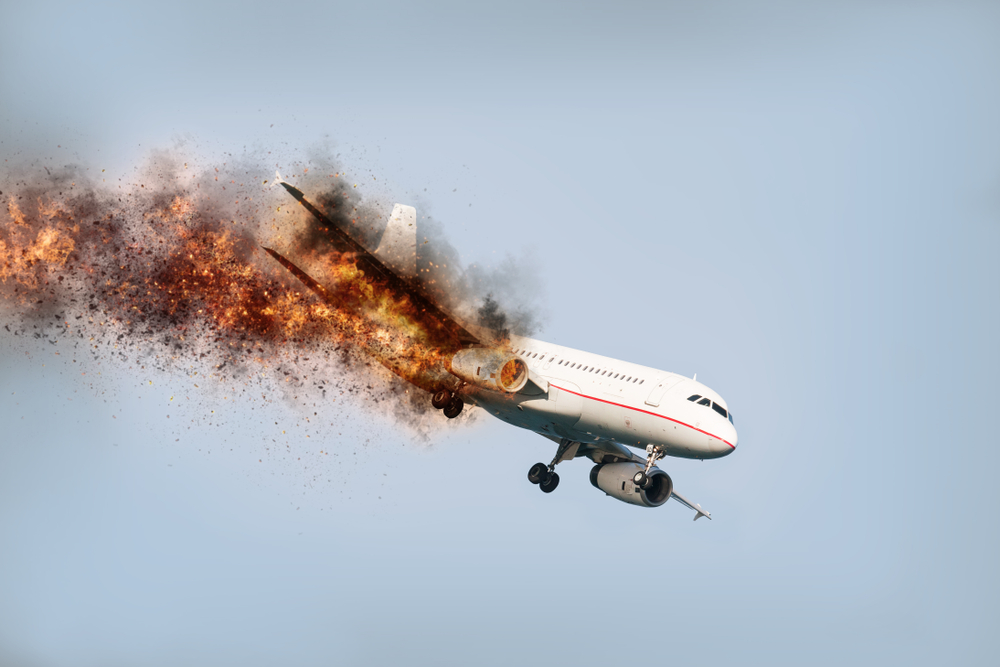A small aircraft crashed shortly after takeoff from Boca Raton Airport on Friday morning, killing all three people aboard and sending debris across nearby transportation infrastructure. The Cessna 310 went down approximately 10:20 a.m. ET after the pilot reported rudder problems and attempted to return to the airport.
Aircraft erupted into flames upon impact
The plane crashed near the intersection of Military Trail and Glades Road, erupting into flames and scattering wreckage across both a roadway and adjacent train tracks. The impact created tremors felt by workers in nearby buildings despite the relatively small size of the aircraft.
First responders arriving at the scene found two bodies visible in the wreckage. A third victim was later confirmed by authorities, though identities have not been released pending notification of family members.
Boca Raton Fire Rescue Assistant Chief Michael LaSalle confirmed that one person on the ground sustained injuries after driving through a fireball created by the crash. The motorist subsequently collided with a tree but survived the incident with non-life-threatening injuries.
Pilot reported mechanical issues moments after departure
Flight records indicate the Cessna 310 was bound for Tallahassee when the pilot communicated mechanical problems with the aircraft’s rudder system. The twin-engine plane had barely gained altitude when the pilot attempted an emergency return to Boca Raton Airport.
Multiple witnesses observed the aircraft flying at dangerously low altitude moments before the crash. Area resident Jared Scarpato was among those who witnessed the plane’s final moments, noting the aircraft appeared to be flying too low for safe operation.
Transportation officials closed both Military Trail and Glades Road following the crash, creating significant traffic disruptions throughout the area. Operations at Boca Raton Airport were temporarily suspended as emergency crews secured the crash site.
Federal authorities launch comprehensive investigation
The Federal Aviation Administration and National Transportation Safety Board dispatched investigative teams to the crash site Friday afternoon. Officials will examine the wreckage, review maintenance records, and analyze communications between the pilot and air traffic control to determine the cause of the crash.
Investigators will focus particular attention on the reported rudder malfunction, examining whether mechanical failure, maintenance issues, or other factors contributed to the fatal accident. The investigation is expected to take several months before reaching definitive conclusions.
Boca Raton Mayor Scott Singer addressed the community following the crash, expressing collective grief over the loss of life. City officials have pledged full cooperation with federal authorities throughout the investigation process.
Second fatal aircraft accident in 24 hours
The Boca Raton crash comes just one day after another aviation disaster claimed six lives in New York City. A helicopter carrying a family of five and their pilot crashed into the Hudson River Thursday after experiencing mechanical failure shortly after takeoff.
The victims of the New York crash included Siemens executive Agustin Escobar, his wife Mercè Camprubí Montal, and their three children, who had traveled to the city for birthday celebrations. The helicopter pilot also perished in the accident.
These dual aviation tragedies occurring within 24 hours have renewed focus on aircraft safety protocols, particularly for smaller aircraft operating in densely populated areas. Safety experts note that while commercial aviation maintains extremely high safety standards, smaller private aircraft experience higher accident rates.
Community response and impact
The crash has profoundly affected the Boca Raton community, with many residents expressing shock at the violent nature of the accident. Local officials have organized grief counseling services for those traumatized by witnessing the crash or its aftermath.
Both aviation and transportation infrastructure suffered disruption following the accident. While Boca Raton Airport resumed limited operations by late afternoon, road closures continued as investigators documented the scattered debris field and collected evidence.
Businesses near the crash site reported temporary closures while emergency responders worked to secure the area. Several local organizations have begun collecting donations to support both the families of victims and the community recovery efforts.
The proximity of the crash to busy transportation corridors has prompted city officials to review emergency response protocols for aviation incidents. While such accidents remain statistically rare, their potential impact on densely populated areas requires comprehensive planning.
As the investigation continues, federal authorities have requested that anyone with information or video footage of the aircraft prior to the crash contact the NTSB. Such evidence often proves crucial in reconstructing the sequence of events leading to aviation disasters.
For Boca Raton residents, the tragic events of April 11 serve as a sobering reminder of how quickly disaster can strike even in seemingly routine situations. As the community begins the healing process, attention will focus on both supporting those affected and understanding what caused this deadly crash.












